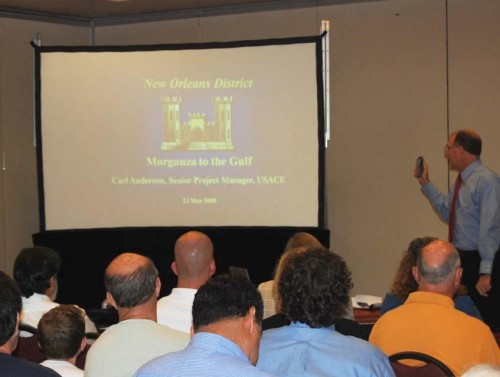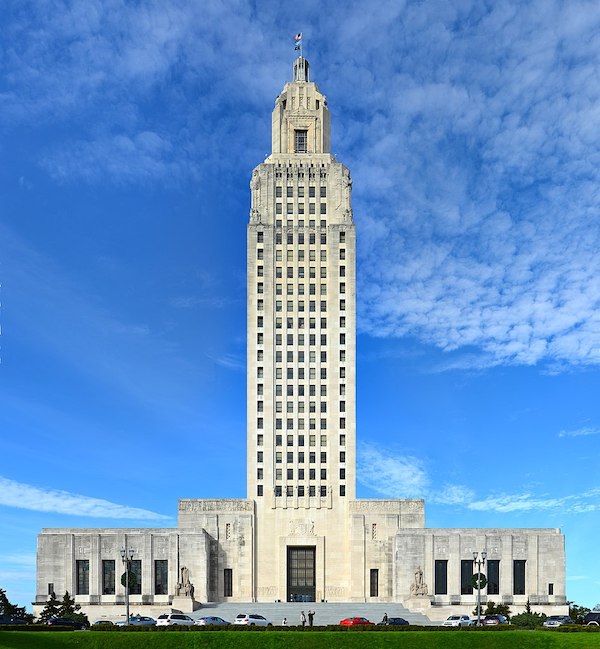
Cleveland Verdin
May 26, 2008
Dr. Charles "Chuck" Binford
May 28, 2008Morganza to the Gulf, the mainly federally-funded construction project bringing hurricane-protection levees to Terrebonne and Lafourche parishes, was scrutinized by a panel of scientists and engineers Friday in Houma during a presentation by the Terrebonne Levee and Conservation District and the U.S. Army Corps of Engineers.
The Morganza Technical Review Panel is meeting once a month until October to gather information about the project for the state Coastal Protection and Restoration Authority, the agency created following hurricanes Katrina and Rita to oversee Louisiana’s wetlands restoration and hurricane protection efforts.
The panel will present a report to the authority on Morganza by the end of the year.
Although money for the billion-dollar project has yet to be appropriated by Congress, 65 percent of Morganza would be paid by the federal government. The remaining 35 percent would be footed through in-kind construction by the levee district and by the state Department of Transportation and Development.
The project will include a lock and floodgate on the Houma Navigation Canal near its intersection with Bayou Grand Caillou, as well as three other floodgates.
Morganza’s 64 miles of earthen hurricane-protection levees will run roughly southwest from Bayou Lafourche near Larose, swing below Lake Boudreaux and parallel Bayou Dularge through an area west of Houma.
In years past, Terrebonne constructed many levees in the parish, though none were designed to withstand flooding caused by hurricanes. Some of the levees are decades old, said Steve Smith with the Houma engineering firm T. Baker Smith, a levee district contractor.
Around 80 percent of the Morganza levee alignment will follow existing levees, roads and bayou ridges, said Morganza senior project manager Carl Anderson with the Corps of Engineers. Little of the alignment cuts through marsh, he said.
The Terrebonne levee district began building the first three-mile stretch of Morganza (called J-1) a few years ago north of Pointe aux Chenes.
In place of paying local match money to the federal government for the project, the district is building four stretches of Morganza levees totaling 15 miles using money generated by a dedicated parishwide sales tax passed in 2001.
The local match is also paying for an access road to the lock on the Houma Navigation Canal.
The sales tax raises $6 million a year because of the parish’s strong economy, Smith said.
“We told the Corps, instead of contributing 35 percent, we’d rather build it ourselves and you give us credit instead of cutting a check to the Corps,” he said.
J-1 is 95 percent complete, Anderson told the panel. The cost of the stretch of levee, originally projected to be $4 million, is $16 million. Some of the levee was constructed using soil from on-site excavation, which is a cheaper process, but most of the material had to be hauled to the site.
Three to four miles of active oil pipeline needed to be moved as well, jacking up the price.
All four locally-designed, Morganza-project levees plug gaps in existing parish levees. Smith pointed out to the panel that hurricane-driven floodwaters have simply rushed through the gaps, flooding communities in south Terrebonne Parish.
He said the four stretches of levee were situated in the southeastern portion of the Morganza alignment because that section absorbs the brunt of hurricanes, as shown by Hurricane Lili in 2002, Tropical Storm Bill in 2003 and Hurricane Rita.
“Flooding runs from east to west in Terrebonne, from Pointe aux Chenes to Dularge,” he told the panel.
Smith also described to the panel a $32 million stretch of levee below Montegut called J-2, which will be constructed by the levee district.
The original design of J-2 showed a jagged, triangular alignment following existing levees and brushing up against Montegut. The alignment could have funneled floodwater toward Montegut.
The new plan for J-2 is mostly a line running further south of Montegut paralleling the Gulf Coast.
The line runs along some existing levees like the original plan for J-2, but much of it goes through open water.
“The area the new alignment goes through has mostly washed away,” Smith told the panel.
The two other levees to be built by the levee district, H-2 and H-3, are located south of Lake Boudreaux and run along a ridge.
Morganza has faced opposition from two Metairie-based environmental groups. The Lake Pontchartrain Basin Foundation claims Morganza’s levees are located too close to the Gulf and will impound wetlands. However, the project will include 13 tidal-exchange structures, allowing water to flow back and forth, Anderson said.
Speaking at the May 14 Terrebonne Parish Council meeting, Councilman Clayton Voisin said the Corps told a delegation of Terrebonne Parish representatives in Washington, D.C., that the corps may recommend moving Morganza’s levee alignment from south of Dulac to Ashland near Houma.
And the Tulane Environmental Law Clinic, on behalf of Save Our Wetlands, sued the Terrebonne levee district for violating the federal Clean Water Act. The clinic is asserting the district did not obtain a permit to discharge dredged material before beginning construction on J-1.
Members of the public listen as U.S. Army Corps of Engineers’ Carl Anderson, senior project manager of the Morganza-to-the Gulf hurricane protection project, details the scope of the work to a Morganza Technical Review Panel. * Photo by KEYON JEFF










